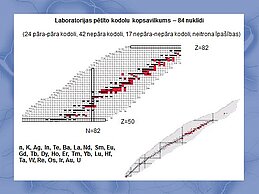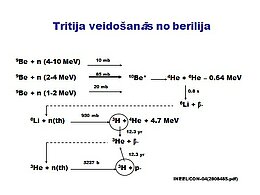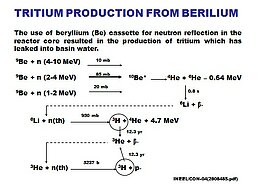The Radiation Physics Laboratory (RFL) of ISSP UL was established in 1999 on the basis of three nuclear research laboratories (the Nuclear Reaction Laboratory, the Neutron Activation Analysis Laboratory and the Laboratory of Radiation Physics of Metals) of the liquidated Nuclear Research Center of the Latvian Academy of Sciences. In 2004, the Radiation Physics of Metals group joined another research laboratory of ISSP UL. Presently, the staff of RFL includes three nuclear physicists: one specialist from the former Neutron Activation Analysis Laboratory and two specialists from the former Nuclear Reaction Laboratory.
Laboratory is engaged both in the fundamental research of atomic nuclear structure, and in the application of nuclear physics methods for the material and environmental studies.
In RFL the synthesis and research of amorphous chalcogenide semiconductor (As-S, As-Se and As-S-Se) thin films and films of organic materials for optical recording and electron beam lithography is performed. Photo-induced changes of optical properties, holographic recording, holographic surface relief formation and relaxation processes in amorphous films are studied. The main task is to perform R&D of high sensitive photoresists in the visible and near UV region for holography and optical resists for production of diffractive optical elements. Rainbow hologram production technology, based on chalcogenide semiconductor photoresists, has been developed.
Equipment:
Optical spectrometers 200 ÷ 1000 nm;
High vacuum equipment for deposition of thin films;
Holographic recording system (laser systems for spectral range of 350 to 1150 nm).
| Scientific degree | Name Surname | Position | Contact information |
|---|---|---|---|
| Dr.phys. | Daina Riekstiņa | Head of the laboratory and Leading researcher | Daina.Riekstina 67261304 |
| Dr.phys. | Tamāra Krasta | Leading researcher | Tamara.Krasta |
| Dr.phys. | Alberts Kristiņš | Leading researcher | Alberts.Kristins |
| Dr.phys. | Ļubova Simonova | Researcher | Lubova.Simonova |
| Jānis Melderis | Leading Radio Electronics Engineer | Janis.Melderis | |
| Juris Veinbergs | Leading Radio Electronics Engineer | Juris.Veinbergs | |
| Sergejs Gvozdevs | Computing Systems Designer | Sergejs.Gvozdevs |
Main research fields of the Nuclear Reaction Laboratory are:
- Experimental and theoretical nuclear structure studies;
- Application of nuclear physics methods for the study of environmental and physical systems
- Monitoring of accumulation and migration of radionuclides in the environment (forest ecosystem, soil and ground water) in the most potentially polluted regions of Latvia
The main focus of the Laboratory is R&D of materials and technologies for applications in holography, lithography, diffractive optics and micro/nano-technologies.
Research areas:
- Photoinduced processes in thin films of amorphous chalcogenide semiconductors;
- Holographic recording in amorphous chalcogenide semiconductors;
- R&D of highly sensitive photoresists for holography and lithography;
- R&D of diffractive optical elements and Bragg grating structures;
- Holographic surface relief formation during processes of exposure to light in amorphous chalcogenide semiconductors and in organic azo-polymer materials.
Research in Progress:
- Photo-induced changes of optical properties in amorphous As-S-Se system;
- Holographic recording and studies of surface relief formation in amorphous chalcogenide and organic material thin films;
- R&D of high sensitivity photoresists for holographic recording in the visible and UV spectral range of 300 - 700 nm;
- Research of planar waveguides based on amorphous chalcogenide semiconductors.
Active projects:
European Regional Development Fund (LIAA administrated)
Development of holographic recording materials based on azo-benzene and epoxy compounds (2020-2022)
Accomplished projects:
Latvian Council of Science
Nuclear structure fundamental studies and nuclear physics practical applications (2009-2012)
Important achievement is the development and model interpretation of the odd-odd 192Ir nucleus level scheme up to ~ 530 keV energy using earlier obtained experimental data. A number of new levels has been added to the 192Ir level scheme. Structure of 192Ir has been interpreted in terms of 21 two-quasiparticle doublets formed be lowest valence proton and neutron orbits. It has been shown that the 192Ir long-lived (241 years) isomer level has structure Kπ=11- (p:11/2[505] + n:11/2[615]) just like in his doubly-odd neighbours 190,194Ir. Three new gamma-vibrational states have been identified in the 192Ir level scheme.
Level scheme of the odd-odd nucleus 188Re has been studied using the thermal neutron capture reaction γγ-coincidence measurement data obtained with big volume Ge detectors in the Rež reactor (Czech Republic), and the single γ-ray spectrum in the energy range from 105 to 1860 keV registered by the high resolution crystal-diffraction spectrometer GAMS5 in Grenoble. The established level scheme of 188Re nucleus includes 175 levels up to ~1.5 MeV excitation energy: 114 negative parity levels, and 61 positive parity levels. The analysis of obtained level scheme in the frameworks of two-quasiparticle and rotor interaction model indicated coexistence of axially-symmetric and non-axial states in 188Re due to the vicinity of the nuclear shape phase transition region.
In 2012, study of the odd-odd 186Re nucleus structure has been started. The thermal neutron capture reaction measurements with enriched 185Re target have been performed in Grenoble. The single γ-ray spectrum has been measured with the high-precision crystal diffraction spectrometer GAMS5 in the energy from 100 keV to 2 MeV. Analysis of the obtained single γ-ray spectrum allowed to determine energies and intensities of more than 500 γ-lines belonging to 186Re. Development of the 186Re level scheme has been started using both our data and the results of the 187Re(p,d)186Re reaction obtained at the Munich Tandem accelerator.
Experimental nuclear studies in RPL are performed in close association with theoretical nuclear structure calculations using both collective (rotor plus particles) and algebraic (interacting boson) nuclear models. These calculations allow to determine the application limits of traditional nuclear models in critical regions when quantum phase transitions from the prolate nuclear shape to oblate and from the deformed shape to spherical are observed. Model calculations performed in the case of odd-odd nuclei allow to obtain information about residual interaction of valence nucleons in a nuclear mean field and to study isotopic dependence of the NN-interaction potential. Also, because of the high density of excited levels, transitional region nuclei are interesting objects for the studies of quantum chaos in its relationship to nuclear shape phase transitions.
In the domain of nuclear physics methods applications, RPL physicists work on monitoring of the artificial radionuclides: 137Cs and 90Sr in soils and conifer needles and tritium in ground and surface waters of potentially polluted territories in Latvia. Data about radionuclide accumulation and migration have been collected over a longer period of time depending on seasonal and climate conditions. Monitoring has been carried out in areas surrounding the decommissioned Salaspils Nuclear Reactor and the radioactive waste repository. Impact of cement-to-water mass ratio on hardening of concrete used for storage of liquid radioactive waste, as well as diffusion of radionuclides 3H and 137Cs in water from the agglomerate cement compound plus water have been studied as well.
Samples of drinking water as well as water used in food industry have been checked for radionuclide content throughout the entire territory of Latvia to meet EU regulations. Detailed studies of natural radionuclide (40K, 226Ra, 232Th, 238U) content in various clay based building materials used in Latvia have been performed.
In addition to carrying out practical activity measurements of environmental and technological samples RPL physicists are involved in development of new applied nuclear physics methods for detecting radionuclides in various matrices using gamma and beta spectrometry. Also, prerequisites are being drafted for re-establishing activation analysis measurements in Latvia to be performed at the future cyclotron center.
Latvia:
- Riga Technical University Institute of Chemical Physics;
- Riga Technical University Institute of Silica Materials;
France:
- Institute Laue-Langevin (Grenoble) (Dr. M.Jentschel);
Poland:
- University of Warsav (Dr. W.Urban);
U.S.A.:
- University of Mississippi (Prof. A.Afanasjev)
- Boise State University
Czeck Republic:
- University of Pardubice
Bulgarian:
- Bulgarian Academy of Sciences
Manika, I. Email Author, Zabels, R., Maniks, J., Schwartz, K., Grants, R., Krasta, T., Kuzmin, A. Formation of dislocations in LiF irradiated with 3He and 4He ions,(2018) Journal of Nuclear Materials, Volume 507, August 15, Pages 241-247 doi.org/10.1016/j.jnucmat.2018.05.005
I.Manika, R.Zabels, J.Maniks, K.Schwartz, R.Grants, T.Krasta, A.Kuzmins. Formation of dislocations in LiF irradiated with 3He and 4He ions. J. of Nucl.Mat., 507, 2018, pp. 241-247.
D.Riekstina, J.Berzins, T.Krasta, G.Kizane, J.Rudzitis. Impact of the former Salaspils nuclear reactor on the surrounding territory. Latvian J. of Phys. and Techn. Sciences, Vol. 52, No. 3, 2016, pp. 67-76.
D. Riekstina, J. Berzins, T. Krasta, O. Skrypnik, J. Alksnis. Longtime radionuclide monitoring in the vicinity of Salaspils nuclear reactor, “Strahlenschutz fur Mensch und Umwelt”, Publication Series: Fachverband fur Strahlenschutz e.V., 2016, pp.182-187.
J. Bērziņš, T. Krasta , L. Simonova, M. Balodis, V. Bondarenko, M. Jentschel, W. Urban, I. Tomandl. Levels of 188Re nucleus populated in thermal neutron capture reaction. Nucl. Phys,. A947, 2016, p.76-126.
M. Balodis, T. Krasta. Levels of two-particle and gamma bands in 192Ir. Nucl.Phys. A933, 2015, pp.189-211.
D.Riekstina, J.Berzins, T. Krasta, R. Svinka, O.Skrypnik. Natural radioactivity in clay and building materials used in Latvia. Latvian J. of Phys. and Techn. Sciences., V. 52, Nr. 3, 2015, pp. 58-66
D. Riekstina, V. Skvorcova, O. Veveris. Application INNA for investigation of magnesium and aluminium materials. J. of Radioan. and Nuclear Chemistry, 2013, V, Issue, pp. 1907-1911.
M. Balodis, I. Tomandl, V. Bondarenko, L. Simonova, T. Krasta, J. Bērziņš. Low-lying levels of 188Re nucleus from gamma-gamma coincidence measurements, Nuclear Physics A 847, 2010, pp.121–148.
D.Riekstina, O.Veveris, A.Skujina, A.Zalkalne. Liquid scintillation spectrometric method for monitoring tritium in ground waters. LSC 2005, Advances in Liquid Scintillation Spectrometry, Univ. of Arizona, 2007, pp.355-358.
J.Proskurins, A.Andrejevs, T.Krasta, J.Tambergs. Studies of Phase Transitions and Quantum Chaos Relationships in Extended Casten Triangle of IBM-1. Physics of Atomic Nuclei (Russia), vol.69, No.7, 2006, pp. 1248-1253.
Trinkler, L., Trukhin, A., Cipa, J., Berzina, B., Korsaks, V., Chou, M.M.C., Li, C.-A. Spectral and kinetic characteristics of pyroelectric luminescence in LiGaO2 (2019) Optical Materials, 94, pp. 15-20. 10.1016/j.optmat.2019.05.014
Mikelsone, J., Teteris, J., Reinfelde, M., Enhancement of Photosensitivity in Azo-Epoxy Resists for Direct Holographic Recording (2019) Optoelectronics and Advanced Materials 13 (11-12), p.576-579)
Tyler Nichol, Janis Teteris, Mara Reinfelde, Maria Mitkova Dual Effect of Light Irradiation for Surface Relief Gratings Formation in Se-rich Ge-Se Thin Films, (2019) Advanced Materials Letters, Volume 10, Issue 12, Pages 868 - 873, 10.5185/amlett.2019.0012
M. Reinfelde, M. Mitkova, T. Nichol, Z.G.Ivanova, J. Teteris, Photoinduced mass transport in Ge-Se amorphous films, Chalcogenide Letters, 15 (2018) 35-43.
A.Gerbreders, M. Reinfelde, A. Bulanovs, A. Tokmanovs, K. Traskovskis, J. Teteris, Influence of acid-base modifiers on photoinduced mass transport in amorphous azobenzene amino acid, Journ. of Optoelectronics and Advanced Materials, 20 (2018) 52-55.
J. Miķelsone, J. Teteris, Surface relief grating recording in azobenzene epoxy films, Journ. of Optoelectronics and Advanced Materials, 20 (2018) 224-228.
J. Teteris, Surface relief grating recording in amorphous chalcogenide and azobenzene compounds, Journ. of Optoelectronics and Advanced Materials, 20 (2018) 229-234.
Ivanova Z.G, Zavadil J., Kostka P., Djouama T., Reinfelde M., Photoluminescence properties of Er-doped Ge-In(Ga(-S glasses modified by caesium halides, Phys.Stat.Sol. (B) 254 (6), 1600662 (2017)
M.Reinfelde, L.Loghina, Z.G.Ivanova, J.Teteris, U.Gertners, S. Slang, M. Vlcek, Photoinduced surface relief grating formation in amorphous As40S60-xSex thin films, JOAM, 18 (2016) 1-4.
U.Gertners, J.Teteris, All-Optical Surface Micropatterning by Electric Field Intensity Gradient, Adv.in OptoElectronics, vol.2015, ID917029 (2015), 8 pages.
J.Aleksejeva, M.Reinfelde, J.Teteris, Direct surface relief patterning of azo-polymers films via holographic recording, Can. J.Phys., 92 (2014) 842-844.
M.Reinfelde, J.Teteris, Surface relief and polarization holographic grating formation in amorphous As-S-Se films. JOAM, 13 (2011) 1531-3.
U.Gertners, J.Teteris, Surface relief formation in amorphous chalcogenide thin films during holographic recording, Opt.Mat. 32 (2010) 807-810.


